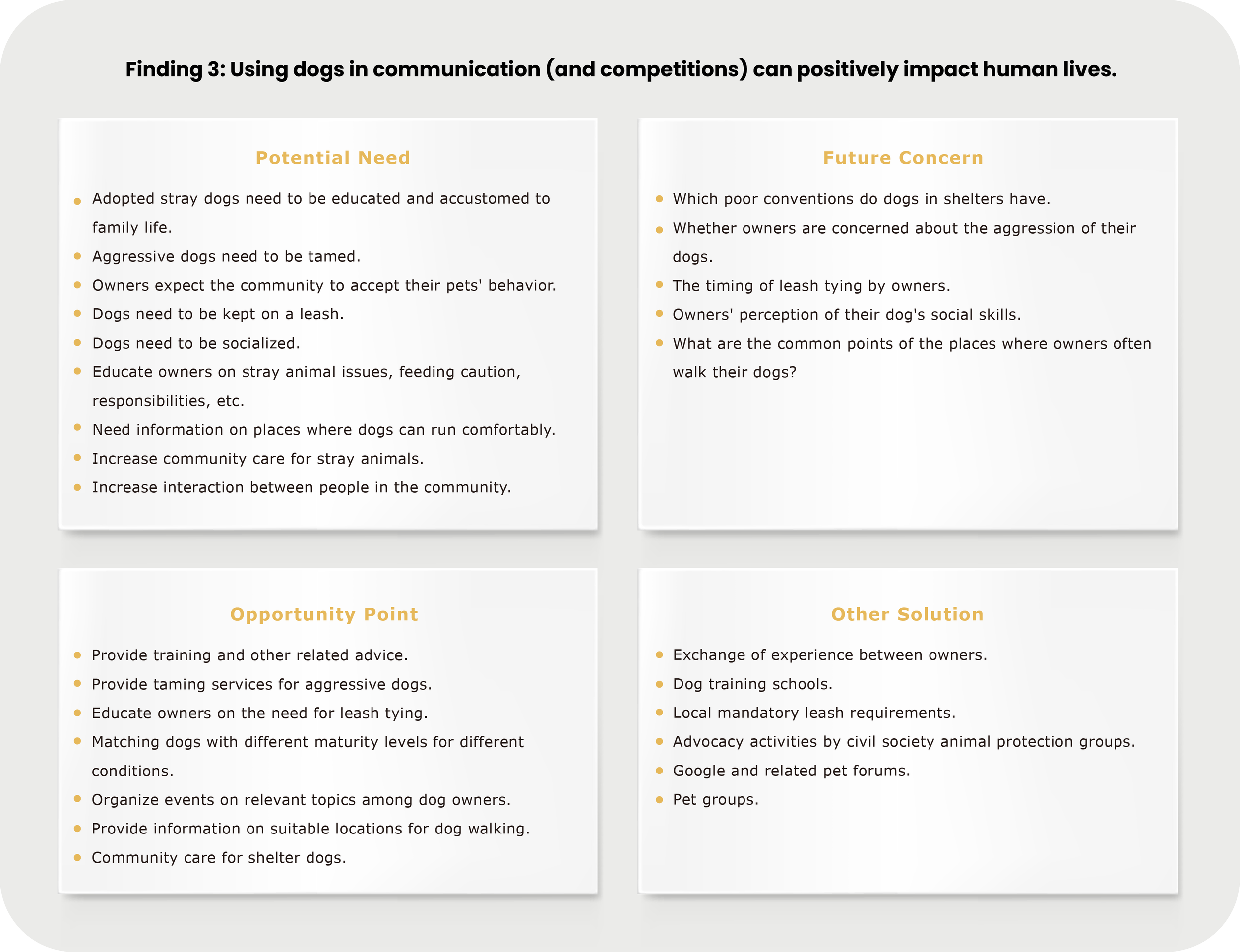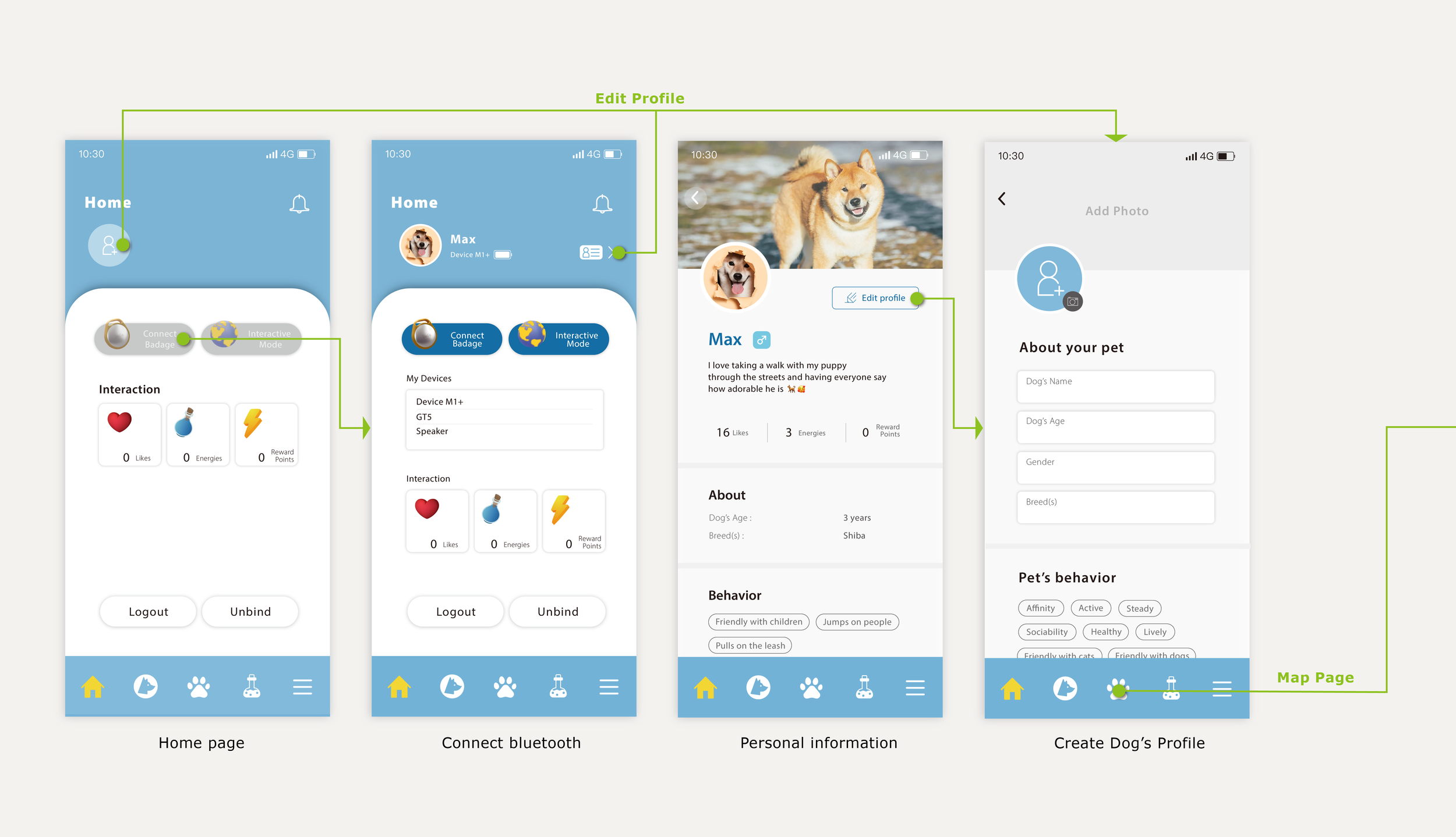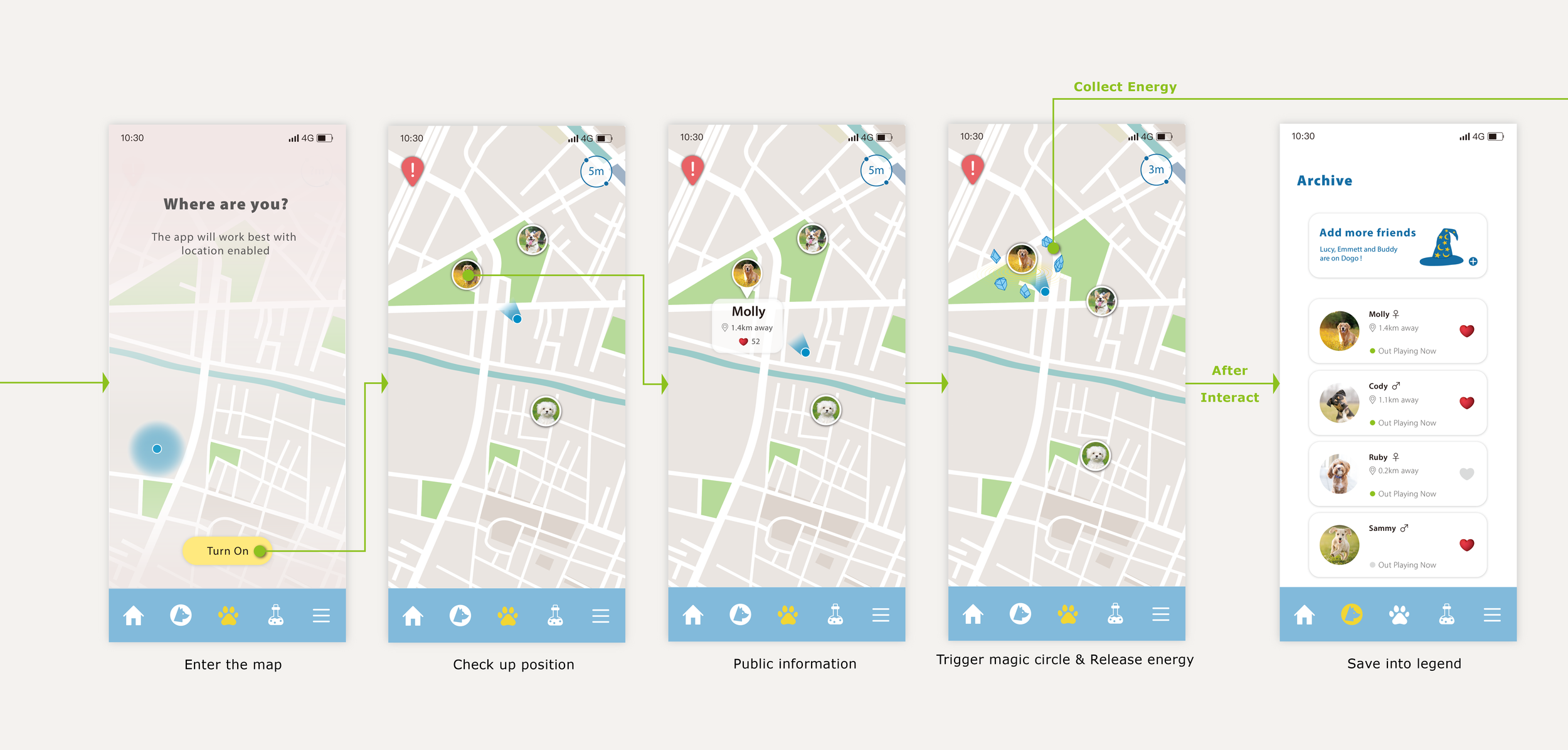
Enhancing People’s Offline Interaction through Dogs and Minimizing Problem Situations between Humans and Dogs.
DoGo
Overview
We have designed and developed a product called “DoGo”, which includes a mobile APP and a matched dog-portable badge with Bluetooth and projection functions. Our product expands the target user group to non-dog-owners as well as those who have a fear of dogs. With the help of location sharing and visualized symbols, “DoGo” can help minimize problem situations, promote positive interactions between humans and dogs, and enhance offline communication between people.
Project Duration
4 months (Feb-May, 2019)
Collaborator
Hao Ping Chien, Xiao Yeu Zhang, Chien Chan Tseng
My Role
UX research / UI design
Tasks
Interview / Affinity Diagram / Persona / Storyboard / Wireframing / Usability testing
Project Background
Humans and dogs live closely intertwined lives. It is easy for dog lovers to interact with their pets, but being around dogs can be stressful for people afraid of dogs. In our daily lives, both positive interaction and problem situations can arise because of dogs.
The Challenge
Dogs are critical mediums of communication between people.
Our team sought to develop a design that would facilitate positive human-dog interaction, enhance interaction and communication between people, and help stray dogs adjust back into the community.

Increase human interaction
Improve human-dog relationships
Feedback and care for stray animals
Design Process
I participated in the whole design process and used multiple methods to develop our work.
Questionnaire
We collected 173 valid samples via online questionnaires
Including 69 dog owners and 104 non-dog owners (30% of whom had regular interaction with dogs and the owners they met)
71% of dog owners often interacted with other dog owners.
53% of non-dog owners and 40% of dog owners said they would join a walk if they knew the dog they loved was playing nearby.
However, some of the respondents expressed concern about their interaction with others, citing one or more of three reasons:
Possible aggressive behaviour by the dog
Fear of embarrassment
Worries about offending others
82% of respondents believed in promoting more interaction between humans and dogs and among humans.
90% thought dogs increased communication and brought positive energy to communities.
Around 80% felt minimizing issues between humans and dogs was necessary, with notices and reminders being helpful.
Contextual Inquiry
We turned to two Taiwanese researchers’ studies about social interactions during a dog walk by a dog owner. We conducted a 40-minute semi-structured in-depth interview for each of the 12 subjects from different fields.
Interviews are conducted for three purposes.
Ownership Status (Emotional connection approach)
Changes in social behaviour after owning a dog
Perceptions of stray dogs
Interviews focused on three subjects
The interviewees included three owners, seven non-owners and two staff.
Discover their experiences of interacting with stray animals or pets respectively.
Through an AFFINITY DIAGRAM, we found that dogs and people live closely intertwined lives, and three social needs need to be met:
✔️ Minimising the conflicts between people and dogs while enhancing opportunities for positive interactions.
✔️ Utilising dogs as a bridge to alleviate awkward human interactions.
✔️ Raising awareness about the issue of stray animals.
Research Findings
To identify the current pain points that users encounter, we mainly focus on challenges such as:
💡 Finding 1: Humans generally try to overcome human–dog problem situations in a humanitarian way.
💡 Finding 2: Many factors must be considered when communicating with a dog.
💡 Finding 3: Using dogs in communication (and competitions) can positively impact human lives.



Understanding the user perspective,
we created the PERSONA to help us move forward with our decision-making.
Considering the personas and research data, I aim to address the specific problem through a targeted question.
How might we…
Considering the pain points of our personas, we generated several potential ideas:
💭 Design a product with a dog as the medium and build offline interaction.
💭 Focus on communication between pet owners and connect with others who do not have pets.
💭 Strengthen community relations and accumulate these interactions into social capital.
💭 Help stray animals through the collective power of social networks.
Operating Model
The diagram outlines the interaction and relationship system of a project called "DoGo," which connects different stakeholders around dog-related activities.
Here’s a breakdown of the system:
Dog Owners and Non-dog Owners interact through an entity called "baggage" and "interactive energy," which DoGo facilitates.
Community Committee plays a role in promoting the project, presumably in public spaces or neighbourhoods.
Brands of Pet provide financial support through advertisements and sponsorships, likely benefiting from exposure in the DoGo ecosystem.
The concept of interactive energy links DoGo with Animal Shelter, suggesting that their interactions contribute to animal welfare or adoptions.
A warning system is implemented to help People who are afraid of dogs, providing a sense of security or control in spaces where dogs are present.
This system creates a network where dog owners, non-dog owners, and even those uncomfortable with dogs can coexist and interact safely. Community bodies and brands are also part of this network, contributing to its growth and sustainability.
Storyboard
We used a storyboard to define identities and connect roles, scenes, and key steps in product use. The system’s background is a magical world where dogs are magicians spreading happiness, and humans are their guardians.
The product includes a Bluetooth wearable device (called a portable badge) with a projection feature and a mobile APP.
Design: Portable Badge
Owners connect their app to a Bluetooth dog badge to interact with others, with dogs as the medium. The badge projects a magic circle onto the ground, indicating the owner's openness to interaction and preventing awkward situations.
Design: Mobile APP
With the magical world as the background, the APP includes three interfaces: the magic map, the magical energy, and the magician legend.
Function Structure
Usability Testing
We tested the product with five individuals from different backgrounds, including users who feared dogs and left positive feedback. Key improvement suggestions include:
Provide more information on dog locations, interaction heat maps, and energies received/donated.
Visualize data on asylums or dogs that helped retain users.
Improve the feedback system to make it more engaging and encourage owners to share their locations.
Main Features
Onboarding Flow
Home Page
The home page shows essential information for users. There are three interactive data Likes, Energies, and Reward points. When the owners walk the dogs out, they can have the dogs wear the portable badge and connect the badge to the mobile APP.
Create Your Pet’s Profile
This screen collects some important information about your pet. The user could add details to make others know your dog better.
Interact with Owners & Their Dogs
Users can turn on the location to find the position of other owners using this app and their dog's information. The magic circle will release energy when the distance between the owner and non-owner user is no more than 2 meters and more than 30 seconds. The reaction between owners will double the radiation range of the magic circle.
Make New Friends
After interacting with the dog, its information will be automatically saved in the app's legend interface. Then, the users would click on the heart-shaped icon to "like a dog." Dog profiles, the number of hearts that a dog owns (representing the affinity), and whether dogs are online (meaning they go outside) or not can be viewed on the legend interface, too. Or, the users could set a notification alarm when the dogs that they like go outside.
Energy Collect & Giving Back
The magical circle would disappear when the users are beyond the interaction range. Still, the energy would be saved at the interaction location until midnight so the users can click to collect it. After that, users can check accumulated points on the magical bottle interface. When the collected energy reaches the required amount, the app will donate resources to the asylum, advancing the story's plot.
User Flow



Warning System
Those afraid of dogs can enable positioning to check the dog's location to avoid possible encounters. They can also choose to be close to a kind dog through the rating system.
In addition, all users can mark dangerous locations on the map and notify users within a specific range. The danger marker will stay on the map for 10 minutes.
Warning System Flow
Conclusion
💬 This product stands out by including non-owner users and addressing the needs of those afraid of dogs, promoting offline interaction and strengthening community ties. The storytelling aspect also makes it more engaging. However, due to limitations in technology and time, we haven’t measured the product’s real-world effectiveness or determined if dog owners will adopt it.
💬 Future research should focus on wearable devices and emotion tests to tell the difference between positive and negative energies or show dogs' emotions to avoid problems. Also, with recent advances in chip technology and GPS, we could use this device to track and find stray dogs, providing information to help improve their situation.
Moments
▪️Design Team
▪️Brainstorming Process










































